Bedford Highlanders
Bedford Billets
Places > Bedford > First World War > Regiments | Bedford Highlanders Home
"There are only 40,000 inhabitants here, and with 25,000 troops billeted
on them you can understand there is hardly a house without men in it: and yet
they say that they hope we won't go for a long time. And that when we do go they
hope they will have more Scotties come to take our place."
Letter from
Capt. Stewart Coats, Argyll and Sutherland Highlanders, Bedford 1915
Bedford rallied to support the soldiers and worked hard to look after the well-being of the men. Many households which didn't have soldiers living with them, opened their homes to men who were living in unfurnished billets, providing hot baths and laundry facilities amongst other things.
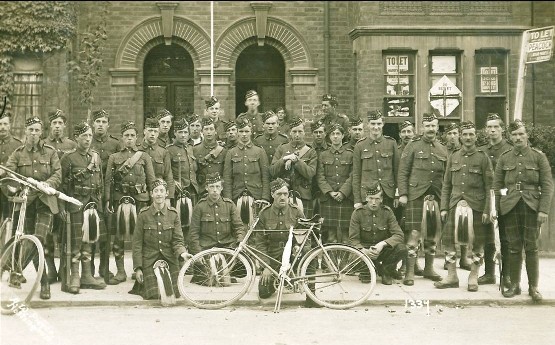
Men of the 6th Seaforth Highlanders outside their unfurnished billet in St. Michael's Road, Bedford. Photographed by A. W. Pierce of Nottingham in November 1914.
As is clearly evidenced by the estate agent's signs, this house was one of the many large Victorian and Edwardian villas in the centre of town which were uninhabited when the Highlanders arrived. These properties provided excellent billets and anywhere up to 6 men would be allocated to each room. Whilst many of these new houses would have benefited from the 'mod-cons'of running water, flushing toilets, gas lighting and even electric lighting in some cases, the houses were unfurnished and living conditions were spartan. The men slept on bare floorboards and had few creature comforts. In the summer months, this was less of an issue, but as autumn 1914 gave way to a particularly cold and wet winter, the men in unfurnished billets were generally living an uncomfortable life. (Photograph: courtesy of Richard Galley)
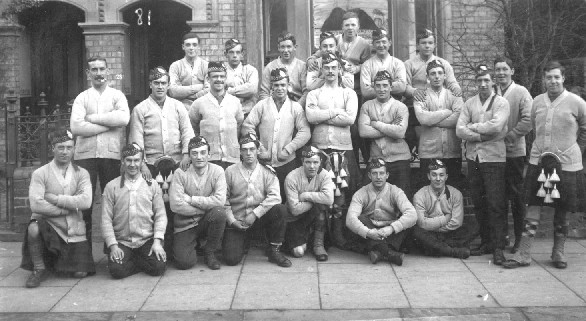
Men of no. 3 Section 'C' Company, 9th Argyll and Sutherland Highlanders who are proudly showing off their new cardigans outside an unfurnished billet at 23, Goldington Avenue. These men are from the battalion's Dumbarton company . Someone has gone so far as to ‘etch'an impression of Dumbarton in the whitener on the centre bay window! (Photograph: courtesy of Richard Galley)
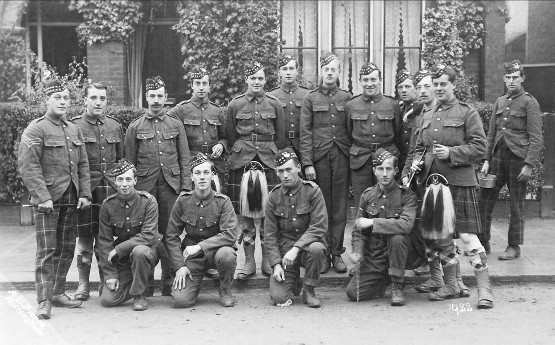
Men of No. 2 Section, 'B'Company, 6th Seaforth
Highlanders photographed outside their billet on 1st
November 1914, somewhere in the 'Saints' area (all
streets being named after Saints) of Bedford, bordered
by Kimbolton Road, Park Avenue and Pemberley Avenue.
The photograph was taken by A.W. Pierce of Nottingham
who seems to have had a special affinity for the
Seaforth Highlanders and walked the streets of the
Seaforth and Cameron Brigade's billeting area taking
photos of the men outside their accommodation. Once
developed and printed in the form of Post Cards, he
would then sell these back to the men featured. (Photograph: courtesy of Richard Galley)
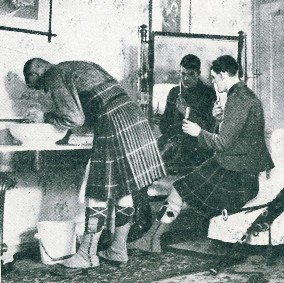
When the Highlanders arrived in Bedford it had been
the intention to accommodate the men in the unoccupied
houses available in town. However, there were too many
men for the number of vacant properties available and so
the towns people were asked to open their doors to the
soldiers.
"The Officer Commanding publicly expressed
to the people of Bedford his grateful acknowledgement of
the many acts of kindness bestowed on the men. There was
no trouble in billeting them. People who had never been
known to take in lodgers gladly threw open their doors,
and took the strangers in. Every empty house was
commandeered and filled before householders were called
upon."
'The Highland Division at Bedford – An
Illustrated Souvenir': Beds Times 1915
In this
photograph we see Seaforth Highlanders (either 4th, or
6th Battalion) in their Bedford billet. This photograph
was published in the August 1914 edition of the monthly
magazine 'War Illustrated'. The man bending over the
washing basin is a bagpiper. He wears the McKenzie
tartan hose tops, as opposed to the red and white diced
hose tops worn by non-pipers of the Regiment. His
bagpipes are laid on the chaise longue behind him.
These men are accommodated in a furnished billet, where
they enjoy carpeted floors and proper furniture. No
doubt the house provides warmth, comfort and the
additional care and attention provided by the
householders which is something that the men living in
unfurnished billets could only dream about.
(photo:
courtesy of Richard Galley)
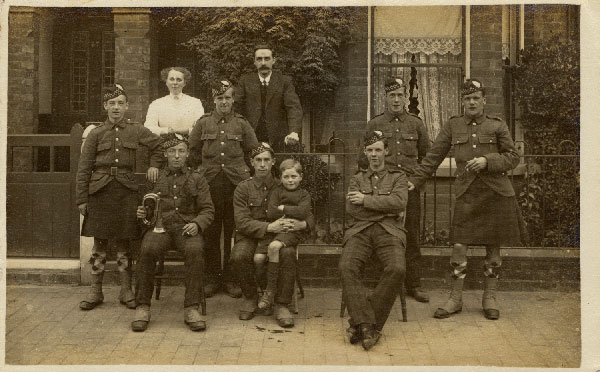
The soldiers who were billeted with the townsfolk were
well looked after and were often treated like family
members by the householders who accommodated them.
Strong, genuine and long lasting bonds were forged
between the soldiers and the families they lived with.
One Highlander who joined-up whilst under age in
August 1914 survived the War and returned to Bedford to
marry a local girl and settle in the town. His daughter
remembers that he always called the landlady who he'd
been billeted with in Howbury Street, 'Mum'.
After
the Division left Bedford and went into action in France
and Flanders, many of the men would write to their
former landlords and landladies providing updates on
their well being and life in the front line. These
letters were often published by the 'Bedfordshire Times'and certainly for the best part of 1915 the local papers
carried as much information about how the Highlanders
were getting on in action as they did about
Bedfordshire's own fighting men.
In this photograph
(Bedford and Luton Archives and Records Service), Argyll
and Sutherland Highlanders are posing in front of 65
Dudley Street, with their host family.
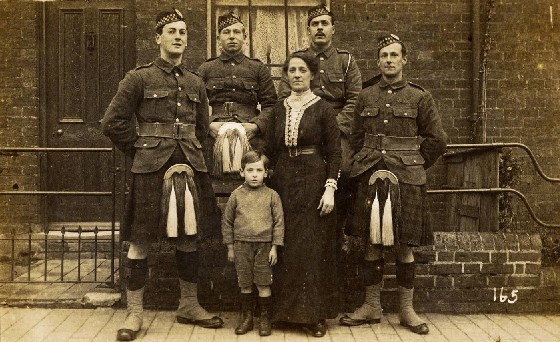
5th Seaforth Highlanders outside no. 9 Beaconsfield Road, Bedford with their landlady and young boy. (Bedford and Luton Archives and Records Service).
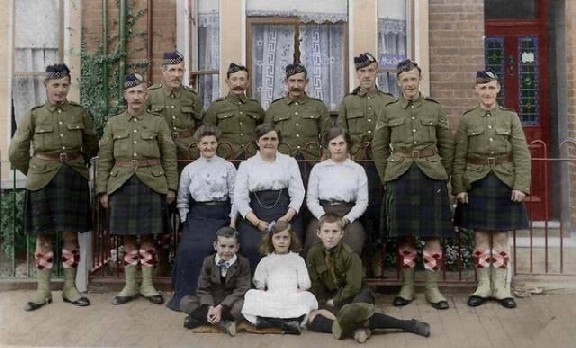
This picture shows Argyll and Sutherland Highlanders
with landladies and children in the Castle Road area of
Bedford. The landladies paid close attention to the
welfare of the soldiers who were billeted with them and
they were a force to be reckoned with when it came to
protecting the well being of the men.
There are
accounts of groups of landladies besieging overworked
Adjutants with complaints that the men were returning
home late for their suppers after a hard day's training.
When disease struck the Division in the winter of
1914/15, many of the land ladies would not allow the
sick soldiers in their homes to be taken to hospital as
they believed the authorities were not doing enough to
look after the men and trusted only themselves to do the
job properly.
The children of the town adored the
Highlanders who with their distinctive uniforms, strong
regional accents and different ways, had something of an
exotic aura about them. This was not too dissimilar to
the experience nearly 30 years later when American
servicemen became a familiar sight in and around
Bedford.
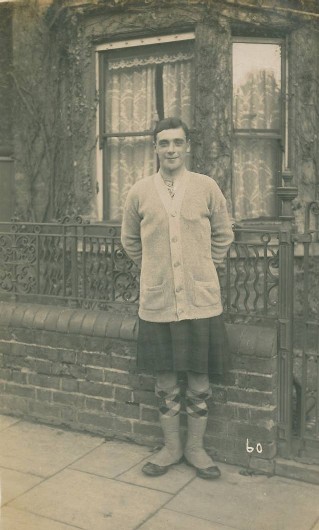
One of the men of no. 3 Section 'C'Company, 9th Argyll
and Sutherland Highlanders outside his billet at 23,
Goldington Avenue. November 1914
(photo: courtesy of
Richard Galley)
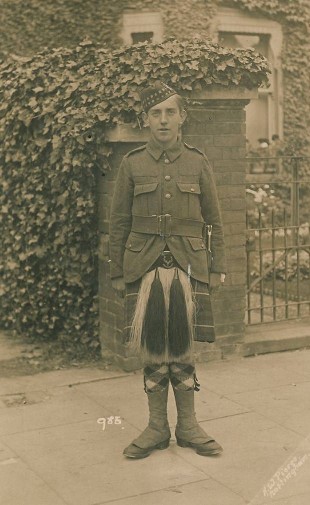
'Wee Jock'– a diminutive Seaforth Highlander (either
4th, or 6th battalion) outside his Bedford billet.
(photo: courtesy of Richard Galley)
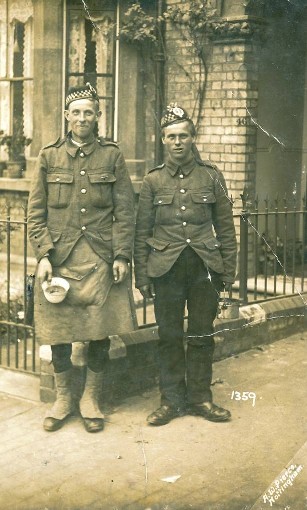
Two likely looking lads of the 5th Seaforth
Highlanders outside their billet at 46, Clarendon
Street, Bedford.
From head to toe, the uniform of the
5th Battalion Seaforth Highlanders differed
significantly from all other Seaforth Highlander
battalions. They wore a Glengarry with a different
pattern of dicing (the checked band around the hat)
which was similar to that worn by the Argyll and
Sutherland Highlanders. The 5th Seaforth had their own
cap badge and they wore the Sutherland tartan, rather
than the McKenzie. Their dress sporrans were dark brown
with two white tails, as opposed to white with two dark
brown tails and finally, their hose tops were diced red
and bottle green, rather than red and white.
(photo:
courtesy of Richard Galley)
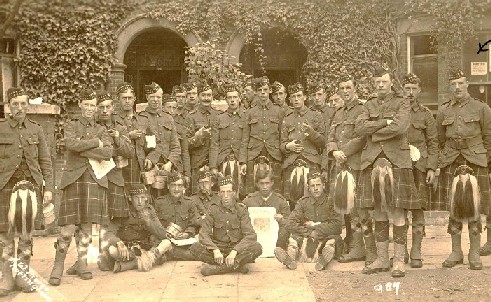
This photo in the form of a post card was sent to Mr. R.
Welsh, 28 Grafton Street, Glasgow, by one of the men in
who posed for the picture. He was a member of the 4th
Battalion Seaforth Highlanders and was billeted at 24,
De Parys Avenue (24, De Parys Avenue is located directly
opposite the entrance to Burnaby Road). The message on
the back of the card reads:
"24 de Parys Avenue
H Coy 4th Seaforth Highlanders Bedford -12.9.14
Dear Bob,
Getting here A1, no word of shifting yet.
We are having inoculations against typhoid fever
today. Kind of vaccination business.
This photo is
taken outside the empty house we stayed in. Each Co.
(this is some of them) is about 100 strong now.
Piles of recruits have joined us from London and
Bedford. Bn. is 30 men over strength now.
How is
Jock getting on? He will be starting shortly.
Good
luck,
Walter."
(Photo: Bedford and Luton Archives
and Records Service)
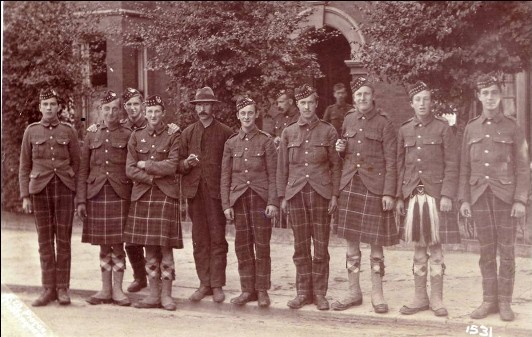
Members of the 6th Seaforth Highlanders outside their
billet in the Saints' area of Bedford. A local civilian
is included in the group.
(photo: courtesy of Richard
Galley)
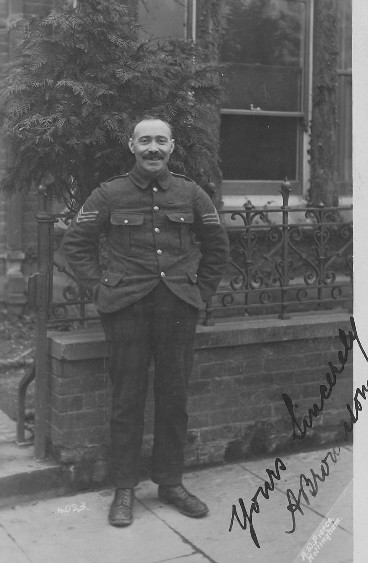
Sergeant A. Brownson of the 4th Cameron Highlanders.
Photographed outside his billet in the Clapham Road area
of Bedford, by A. W. Pierce of Nottingham.
In October
1918, Assistant Quartermaster Sergeant A Brownson,
Cameron Highlanders was awarded the Distinguished
Conduct Medal. The citation for this award reading:
"For conspicuous gallantry and devotion to duty. Though
forty-nine years of age and with twenty seven years'service, this N.C.O. has endured the rigours of the
campaign for nearly three years at the front, performing
his duties, often under difficult and dangerous
conditions, with a zeal and ability worthy of the
highest praise. He has never failed to deliver
personally the stores and rations to the Brigade, when
in the front line, frequently under very heavy fire,
during some of the hardest fighting of the war. His
devotion to duty has been a very fine example."
(photo: courtesy of Richard Galley)
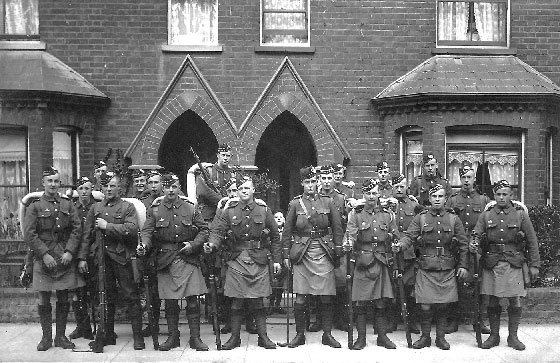
Gordon Highlanders photographed outside 17, Spenser Road, Bedford. This photograph is in the collection of Mr. Christopher Macdonald whose grandfather was a member of the 4th Gordon Highlanders.
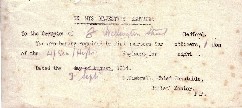
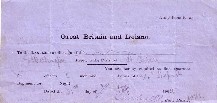
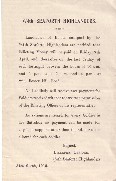
Original Seaforth Highlander billeting slips for
properties in Wellington Street and Foster Hill Road.
Those people who had soldiers billeted with them, or in
property that they owned, were paid a daily allowance by
the Army. In today's money the amounts were roughly
equivalent to:
Furnished billet - 4p per private
soldier / Non-Commissioned Officer - 15p per officer
Unfurnished billet - 1½p per man, regardless of rank
(photo: courtesy of Richard Galley)
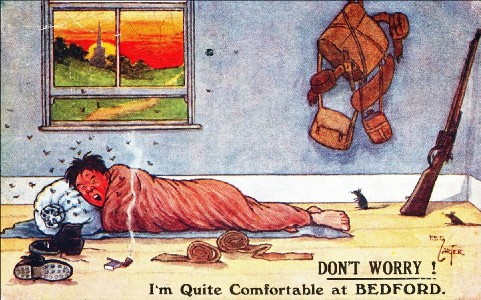
This post card was sent from Private Jack Watling to his
mother in 1916, long after the Scots had left town.
Although it is meant to be a humorous depiction of a
soldier's life in a Bedford billet, it does accurately
portray the conditions which the Highlanders who were
placed in unfurnished houses had to face, particularly
in the first couple of months of their time in town.
Sleeping on bare floorboards, using a Great Coat as a
blanket and kit bag as a pillow.
The modern
houses-cum-billets offered creature comforts that many
of the soldiers had never experienced before; hot and
cold running water and gas to burn. "There were many men
of most excellent character who came with us from
Scotland, who had rarely seen a house like any one of
these Bedford residential properties and who had
certainly never been inside one. One such soldier after
a long day in the country was washing his socks in that
small compartment described by the House Agent as a
'Gent's Cloak'. "What do I do when I want any more
water, Jock?" he shouted to his companion in the room
outside. "Pull the Plug" [chain]. "Christ!" he exclaimed
as he watched their departure." 'Behind the Lines'; Col
W.N. Nicholson, CMG, DSO – Jonathan Cape Ltd 1939
(photo: courtesy of Richard Galley)
Page last updated: 15th July 2014
